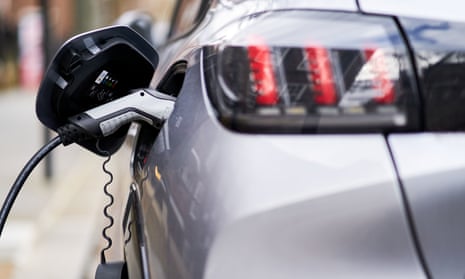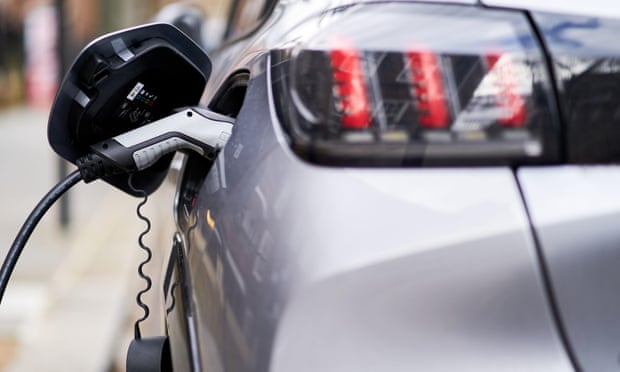
Electric vehicle public charging ‘deserts’ revealed across Great Britain
Three-quarters of households that park cars on street do not have charger within five-minute walk, data shows
North-east Derbyshire and Redditch, in the West Midlands, are among the worst public “charging deserts” for electric vehicles in Great Britain, according to an analysis that found 9.3m households do not have off-street parking where they could install a charger.
More than three-quarters of households that park their cars on the street do not have a public charger for electric vehicles within a five-minute walk, according to the analysis by the Field Dynamics consultancy.
The number of places to plug in is increasing rapidly, with a 46% growth in the number of public chargers across the UK in the year to July 2023, according to the data company ZapMap. However, regulators are concerned about big areas known as “charging deserts”, particularly outside cities, that are not served adequately by the public network.
The average gap between London’s coverage and the rest of Great Britain is growing, from a 32 percentage point difference in 2020 to a 47 percentage point difference this year. In 38 local authorities, less than 10% of households have parking covered by the public charger network.
Craig Stephenson, the managing director of Field Dynamics, said councils should be “making sure they are covering not just the areas with high EV adoption at the moment, but looking to provide infrastructure across their boundaries”.
For many households in the UK, having an electric car makes financial and practical sense compared with a petrol or diesel version.
However, there is a divide between those who can charge at home, and those who have to rely on the public network. Some drivers who do not live within walking distance of a public charger might be able to use rapid chargers farther afield, but that would entail waiting with their vehicle and probably paying higher prices.
Quick Guide
Electric vehicle charging speeds
Show

Not all chargers are created equal
More and more people are buying electric cars, and are having to grapple with charging for the first time. However, not all chargers are created equal, and the profusion of units can cause confusion.
Charging speeds are measured by power output in kilowatts (kW), while battery capacity is measured in kilowatt hours (kWh). For example, a Nissan Leaf has 39kWh of battery capacity, while a Tesla Model Y has 60kWh.
Recharge times vary depending on battery size: divide the battery size by the power to get a very rough idea of how many hours it will take to charge. (E.g., a 60kWh battery at a 22kW charger would take about three hours.) The quicker the charge, the more it tends to cost.
Slow: 3kW to 6kW
Common at homes, and on-street chargers. Suitable for charging overnight. Plugging in with a UK three-pin plug to the mains at home will deliver about 2.3kW – although it is not recommended.
Fast: 7kW to 22kW
Found at urban sites like supermarkets and shopping centres. Capable of charging a smaller battery in a few hours.
Rapid: 23kW to 100kW
Motorway service stations and dedicated public charging hubs. 50kW could give an 80% charge in less than an hour.
Ultra-rapid: 100kW and above
Some of the newest and most expensive cars can handle power up to 270kW, adding hundreds of miles of range in 10 minutes.
Field Dynamics has worked out which households will be reliant on public chargers. It used an algorithm and Ordnance Survey data to find “parkable” parcels of land big enough to fit a Ford Fiesta beside properties. It worked out that 9.3m of the 28.4m households in the UK did not have parkable off-street land where they could install their own charger. Using public charger data from ZapMap, it then worked out how many of those households were more than five minutes from a public charger.
Rural and suburban households often have off-street parking, but many in towns and villages do not, particularly in places laid out before car ownership became widespread from the late 1950s onwards.
North-east Derbyshire’s charger network only covers 1.3% of “on-street” households, many of these in the villages surrounding Chesterfield.
The next worst place is Redditch, despite being home to several car-parts makers in the West Midlands automotive heartland. Only 3.2% of on-street households are covered.
In contrast, Westminster, and Kensington and Chelsea – two of the wealthiest areas in Britain – cover 99% of households. London also has four times more chargers per household than the rest of the UK.
However, some local authorities outside London also have impressive charging networks. Brighton, which is both affluent and a longstanding stronghold for the Green party, has 83% coverage, while Coventry has 76% coverage and Portsmouth 58%. In addition, some relatively rural councils have done well: East Lothian, near Edinburgh, has covered 54% of households.
Quentin Willson, the founder of the FairCharge group campaigning for electric cars, said: “It’s very clear that the local authorities that have been historically very pro-EV have the best coverage. I was talking to Coventry and Brighton about their EV infrastructure strategies years ago – and now their focus has paid off.
“But local authorities need more government support and private-sector guidance on the technicalities of building future-proofed infrastructure, along with easier access to the government’s £450m Levi (local electric vehicle infrastructure) funding. If government doesn’t help and support local authorities, then the local infrastructure rollout will stay regionally patchy and inconsistent.”
after newsletter promotion
Field Dynamics’ data reveals often stark differences in coverage within short distances. For instance, Sefton, in Merseyside, only has 3.7% of on-street households covered, making it the fifth worst in Great Britain. Next door, Liverpool reaches 52.5%, putting it among the country’s best areas.
Sefton council said it was working on a charger strategy for later this year, focusing on provision in car parks and community spaces, as well as applying for Levi funding.
Redditch council said it was “aware of this issue” and “working on it with partners”, pointing to a contract to install chargers on council land and plans under consultation for a charger strategy by the broader Worcestershire county council.
A spokesperson for North East Derbyshire council said it is installing more rapid chargers and that it has applied for Levi funding to expand the network further.
The top 10 local authorities are all in London
Kensington and Chelsea, 99%; Southwark, 99%; Westminster, 99%; Islington, 98%; Hammersmith and Fulham, 97%; Camden, 96%; Merton, 95%; Hackney, 94%; Waltham Forest, 91%; Lambeth, 91%.
The top 10 local authorities outside London
Brighton and Hove, 83%; Coventry, 76%; Portsmouth, 58%; East Lothian, 54%; Watford, 54%; Liverpool, 53%; Clackmannanshire, 49%; Shetland Islands, 48%; Exeter, 44%; Orkney Islands, 44%.
The bottom 10 local authorities
North-east Derbyshire, 1.3%; Redditch, 3.2%; Neath Port Talbot, 3.4%; Brentwood, 3.6%; Sefton, 3.7%; Fenland, 3.8%; Basildon, 3.8%; Bolsover, 4.1%; Walsall, 5.1%; Mansfield, 5.1%.